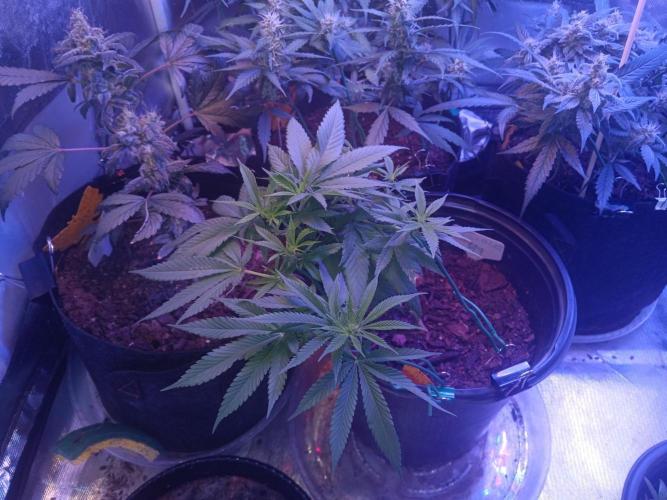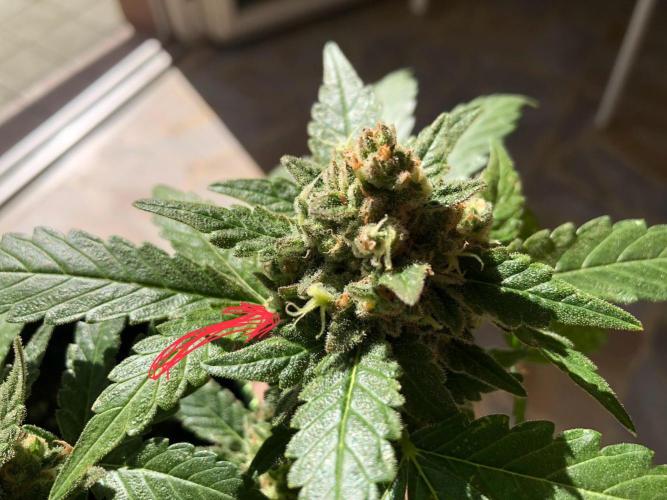The Grow Awards 2026 🏆 



















Leaves curling and pointing down
Cannabisflakesstarted grow question 3y ago
I'm getting worried with these leaves pointing down. Everything is the same for all 3 plants. I noticed signs of flowering on girls N2 and N3.
What should I do guys? Help please 😭🙏
likes
GrowingGrannieanswered grow question 3y ago
2 issues that I see here - you're not giving her enough water if you're only giving her, on average, 0.13 gallons of water a day and she's this old... you need to soak her thoroughly so there is runoff in your tray/saucer/whatever... let her sit for a bit to see if that water is soaked back up into the pot - if it is, give her more water - and do this until no more water is soaked back up and then pitch whatever is left in the tray/saucer. And while you're doing that, you've got to lower that pH as a pH of 7, although they say weed can be grown with that, is in reality much too high for a lot of nutrients to be absorbed by the plant. The pH should be between 6.0 and 6.5 in a soil grow.
Fix those two things and you should see good improvement. Good luck!
Dutchmonkeyanswered grow question 3y ago
Question is so gottagrowsometime can scam a contest.
likes
Complain
Sciolistic_Steveanswered grow question 3y ago
if your diy lights are powerful, you may need a little less light (more height could do it or slight dim -- height ismore wasteful but more photons probably hit the lower areas too... more list to absorption/missing plant also)
if your lights are good for 12/12 18-20" away, then you need 66% of that power over 18 hours.
if you know umol/s of your lights, it's easy to calculate DLI (or use a phone app and take several measurements across canopy.) umol/s divided by m^2 of coverage = X then reference a daily light integral table (google image) for 18 hours and the PPFD value you just calculated..
that's just total dli produced by light. The distance from canopy will usually be dictated by required coverage (geometry), but extra inches needed if too intense for 18 hours per day..
i noticed diy 240w lights and usually these lights don't cut as many corners and are fairly high-end. My 240w lights produce nearly 700umol/s of PAR. (700 / .84m^2 =833 ppfd at 18hours is 54 DLI ... i'd definitely give my plants light burn at 100% from my normal distance in bloom. Dim light slightly but also raise it 2-4 extra inches.
invese square law -- 1/d^2 * 100%
so if you go from 18" to 24" (1+ (24-18/24)=1.33) --Then, 1/1.33^2 *100% = 56% of previous intensity for entire area of coverage at new plane 6" further away than 18" original height -- this is more complicated by many single points of light adding together.. your central par values under light will not be 56% of what it was, but it will spread out to edges more. The total light /area will add up to 56% on that plane. the area enlarges in proportional manner.. again tent walls are being ignored here too. but, this is cause and effect of what is going on regardless of it getting messy. If you have your canopy coverage evened out, it should work effectively to reduce dli at canopy. it does not take much proportional distance change to make a big impact either.
2 likes
Complain
gottagrowsometimeanswered grow question 3y ago
Hey Pal.
Its not overwaterimg. As your leafs look very thin and life less. Maybe your substrate is so loose its finding it hard to drink. As I've no idea where your soil is. Best thing to do is pour water around the whole pot and if she doesn't pick up. You'll be best to pad a bigger pot with soil with good drainage holes will do the trick. But maybe the watering at least once a day. All round the pot. And whatever way you do your fert feeds. Good luck.
1 like
Complain
CULTIVATORFROGanswered grow question 3y ago
Hola !!!! Para mi punto de vista no le falta riego. Hay mucha humedad en tu sustrato. Tambien veo que tu ph esta en 7. Trata de bajarlo a 6.5. Y tambien subiria 5 o 10 cmas la lampar. Pero lo que mas controlaria es el riego y el ph. Deja secar tu sustrasto por unos dias . Suerte
1 like
Complain
Similar Grow Questions
Solved

BRLGrow
GerminationGerminating 3 gorila glue from autoseeds
I left them in a cup of water 24hrs, all off them sinks.
I transfer the seeds to jiff pellets....it’s been 12 days and nothing sprouting :(
Should I wait a little more?
Any suggestions?Setup. Strain - Autoflowering
Germination. Pellet
Germination. Other
5y ago
4
4
Solved

Mr_Juice
Nutrientsfriends, what would you recommend me organic nutrients? I don't want to go the mineral way because I want to achieve a great taste of plants.Setup. Strain - Autoflowering
4y ago
5
4
Solved

blendmedmedman
i have fan leaves starting to curl up, its not the roots or over watering, could it be over fertilization? my other plants are looking the way they should. this is my first soil/coco grow. happy frog. i also ran an ionizer after the feed. so any thoughts? thoughts?Week 4
Leaves. Curl up
6y ago
6
7
Solved

NoFaceNoName461
Growing deficiencyHi dear friends,
I need some help on knowing if there’s any problem with my younger plant,
She’s On The first Week And it seems one of the sides is not developing,
Do I let it go like that or should I cut something?
The strain is super lemon haze by Strain Hunters
Leaves. Too few
Leaves. Twisted
4y ago
4
5
Solved

luxgrower
Yellowing leaves & tips curling down on 14th day. Coco / Autopot / Hesi / Mars Hydro fc-1500Would gladly use some help with my first grow 🙏
2 main reasons come to mind after googling:
1. I overwatered thinking it's hard to do since I'm using the Air dome.
2. Too intense light. Was checking a lot of growers that actually grow 24/0 and went for it 75% 40cm.
1y ago
9
5
Solved

Odin9
Spider Farmer SF-4000 dimmableDo any one her run the Spider farmer sf-4000 on 100%?can someone please give me recommendations for height for all stages??Setup. Strain - Autoflowering
4y ago
2
3
Solved

JVKdopegrow
Can this Auto Flower after all? RQS Sweet Skunk Auto grown in Coco/Soil mix/FF TrioShe very likely had defoliation/nutrient issues and completely stopped growing after 4 weeks of veg. I put her outside (Florida sunshine) for a week of flushing and drying out. I was rewarded with some new growth! Can an Autoflower continue growing again and still flower?
4mo ago
4
3
Solved

KarbofosX
Autoflower trainingTell me is it true that autoflowering plants are better not to be trained? I heard that it is too much stress for them and can affect the final result. Thanks.Setup. Strain - Autoflowering
9mo ago
17
10
Solved

SnowBuds
Tips yellowingis this light burn/stress or Defiency?
New growth seems to be lighter green than the rest.
Ph is 6.0
Ppm is 580ish (slurry)
Light was 11inches away from canopy of tallest plant and 12-13inches from other.
Soil is not over watered. Temp is between 68- 72 degrees.
Humidity %50
5y ago
1
2
Solved

SkatehouseFarms
LEAVES ARE CANOEING SLIGHTLY AND DARKENINGBegan my LST and I’m experiencing some darkening in the leaves and theyre seem to be canoeing slightly began to worry :/ please help with any tips or info I looked into it and from what I can find it’s do to n toxicity or light being to close or windburn and overwatering.Week 2
Leaves. Curl up
4y ago
1
1
Solved

Odin9
Can this be a hermaphrodite?? Feminine autoflower seedHi can this be a hermaphrodite week 4 now pisol butt wery fine. Pistol on the other 2 plants I planted the same day.
Setup. Strain - Autoflowering
4y ago
1
3
Solved

ItalianDesertBalcony
Will there always be fresh bud growth on an auto-flower (max thc/no couch-lock goal)?ready for harvest bc most of the pistils are mature? Clearly not yet because of new growth? The trichromes are looking like a mix of clear and cloudy, little to no amber yet. I would like to know if there will always be fresh pastil/bud growth even when she’s ready for harvest?
Buds. Other
Other. General questions
Setup. Strain - Autoflowering
2mo ago
6
Solved

NewJackWeed
Goldleaf grow is taking foreverrrrrThis plant is going on 13 weeks without a flower bud in site. And it seems really lime green? and a lot of purple stems? I'm not sure if something is wrong ugh. These re ILGM autos in 82F/RH 35%. I know below 80 is ideal, but I'm having difficulty keeping the temps down.
5y ago
1
2


















